Configuring Tabular Series Slot Reports
When creating (or editing) a Tabular Series Slot Report configure these four tabs:
• Titles
• Settings
• Slots
• Output
Titles Tab
On the Titles tab, enter text for the following items:
• Output Name: The name of the Output Device for this report configuration. This is not shown in the report.
• Description: Optionally shown in the generated report by selecting the checkbox.
• Table Titles: Shown at the beginning and optionally above each time interval table (on each printed page, if page breaking is selected).
• Table Subtitle(s): a multiple line note shown directly below each Table Title.
Figure 3.2

Titles and subtitles are optionally shown at the beginning of the report or before each interval by selecting the checkboxes. Figure 3.3 illustrates the use of the Table Title and Table Subtitle in both the generated plain text and HTML reports. For the HTML report, title text fonts for both of these titles are configurable. See Output Tab for details.
Figure 3.3

Settings Tab
The Settings tab is shown in Figure 3.4.
Figure 3.4 Screenshot of the Tabular Series Slot Report Setting tab
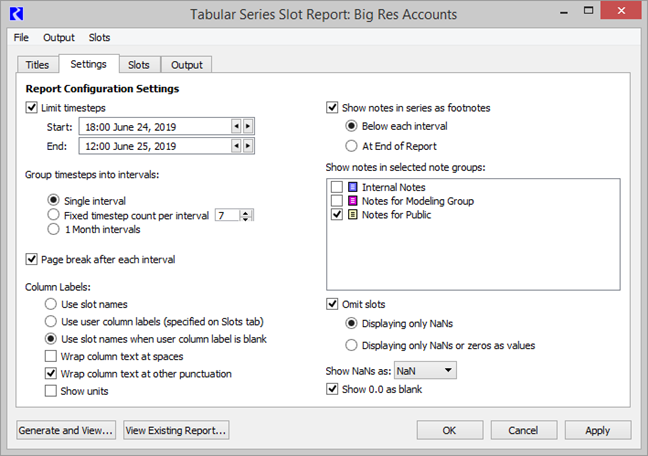
On this tab, you can do the following:
• Optionally limit the series output time range
Note: The timestep size is controlled by the slots chosen. The slots must all have the same timestep size or the model’s timestep size is used.
• Specify how the full time range will be divided into distinct interval tables.
• Optionally break each interval on its own printed page.
• Specify how the column labels appear, as follows:
– Use the Slot name directly,
– Substitute alternate column labels for the full slot names. Alternate (user supplied) column labels are specified for each slot on the Slots tab. (See the image), or
– Use the slot name when the user specified label is blank.

• Wrap column text at spaces
• Wrap column text at other punctuation
• Show units in column headers.

• Choose to show Notes (series text annotations) which have been added to specific timesteps on various series slots. Note text is shown as footnotes, either below each table (on each printed page), or at the end of the entire report. Figure 3.5 illustrates the effect of enabling the display of “notes” within the two types of reports (HTML and plain text). In Figure 3.5, two of the four series slots have notes.
• Choose which Note Groups to show. If showing notes as footnotes, specify which Note Groups you would like to include in the report. This functionality provides flexibility in the content, for example only showing certain notes to a stakeholder group.
Figure 3.5

• Choose to exclude slots displaying only NaN values, or only NaN or Zeros values.
Note: For the second item, the display values (precision, scale, unit) are used in the comparison to zero.
Note: Omit slots that display NaNs or zero as values. Some slots with small values could be omitted with this setting because the slot's unit scheme rules are used for the comparison to zero. For example, an underlying value of 1 cfs displayed on a slot with precision = 2, units = cfs, scale = 1000 is considered zero because the value is displayed as 0.00 1000cfs.
• Show NaNs as:
– NaN
– blank
– 0.0
• Show 0.0 as blank
Note: If you choose to display NaN values as 0.0 and to display 0.0 values as blank, the first control takes precedence; that is, NaN values are displayed as 0.0.
As with various other text components of the report, the font properties (font family, size, color) of the note footnotes are configurable as described in the Output tab section. See Output Tab for details.
Slots Tab
On the Slots tab, specify the slots as an ordered list of series slots.
Figure 3.6

Add slots by choosing slots using the slot selector. This is accessible in the following ways:
• Select Add Slots.
• By selecting Slots, then Add Slots.
Slots in the Slot Clipboard (which were cut or copied from other Slot Lists) can be added to the slot list in these ways:
• Select Slots, then Paste.
• Select Paste (by right-clicking the slot list).
Figure 3.7 shows the context (right-click) menu supported within the slot list. The Cut, Copy, and Remove items operate on the full slot item selection. The Cut, Copy and Paste items interact with the RiverWare Slot Clipboard. These operations are also available in the “Slots” menu.
Figure 3.7
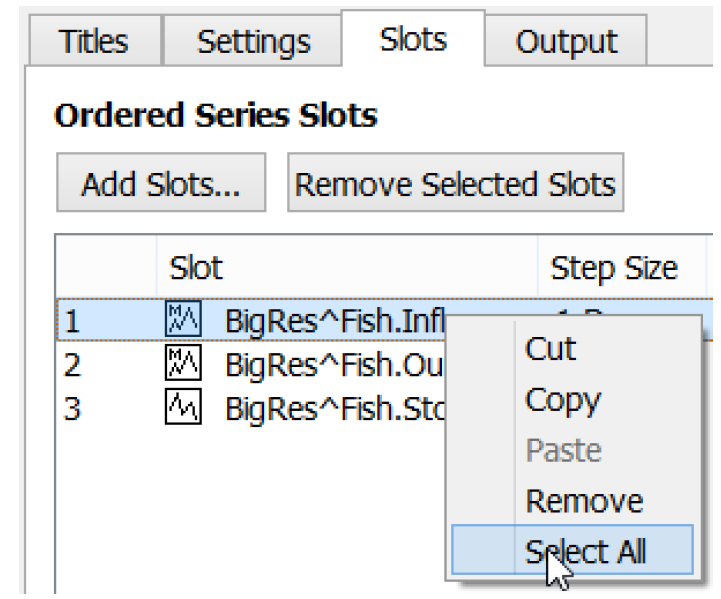
The order of the slots in the list will be used as the order of slots in the generated report. The selected slot items can be moved up or down in the list using the arrow buttons.

Text in the User Column Label column is editable and is used in column headers for the respective slot, based on the configuration defined on the Settings tab. Double-click on that cell to edit the text.
Figure 3.8
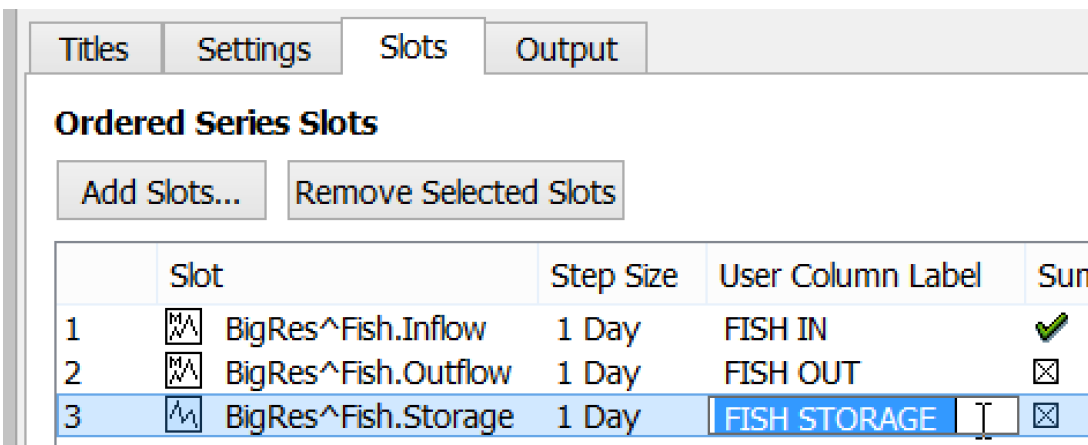
Note: Slots with multiple timestep sizes can be intermixed; each timestep in the model will be shown. If all the slots have the same timestep size, then the report will use that timestep size for display. See Output Devices for Aggregated Values for details on creating aggregated data for display in this or other output devices.
Turn on summary rows for any of the slots (by selecting those cells, to toggle on or off the green check marks), the relevant summary rows are added to the report tables. The following column summary functions are supported:
• Sum
• Mean (average)
• Min (minimum value)
• Max (maximum value)
• Start (the top value in the table column)
• End (the bottom value in the table column)
Note: “NaN” values do not contribute to the arithmetic computation. (In particular, they do not effect the Mean computation).
Figure 3.9

Figure 3.10 illustrates the effect of the summary checks in Figure 3.9, for the HTML and plain text reports.
Figure 3.10

Output Tab
The Output tab is used to specify the file type, path, and any HTML formatting.
On the Output tab, specify the following:
• The type of file to be generated (plain text or HTML).
• The file path where the plain text report file will be generated.
• The file path where the HTML report file will be generated.
Note: File paths may contain environment variables: e.g. ${REPORT_DIR}\MyReport.html
Note: If the file does not already exist, it will be created. If it does exist, it will be overwritten. If the file does not exist, you will need to type in a file name in the file selector.
• For an HTML report file, specify the following:
– CSS style formulas for various types of text appearing in the report. See HTML Report CSS Text Styles for details.
– Background Colors for various table cells. See HTML Report Table Cell Colors for details.
Figure 3.11
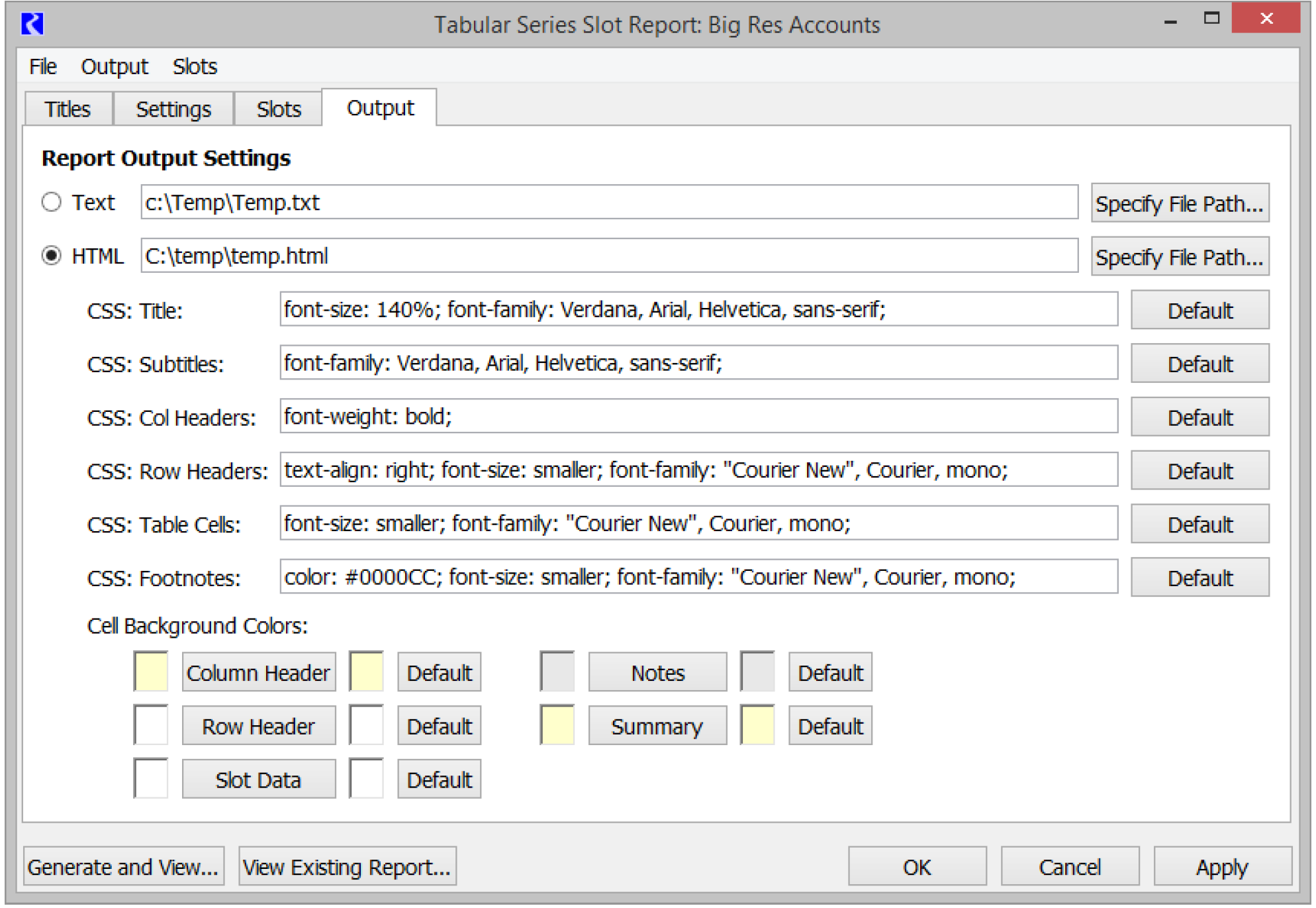
HTML Report CSS Text Styles
The fonts for six different uses of text in the HTML report are configured using Cascading Style Sheet (CSS) formulas. This typically includes font family, text color, size, bolding / italics, etc.
Figure 3.12 illustrates the six different configurable text types. Figure 3.13 (a detail from the Output tab) shows the initially implemented default CSS formulas. The default formulas can be restored by selecting the respective Default button. Hovering over a Default shows the default CSS formula in a tooltip.
Figure 3.12

Figure 3.13

CSS is an HTML-associated style sheet technology standardized by the World Wide Web Consortium. See the following URL:
Many free tools are available which can be used to create CSS style formulas, including most HTML editors. Following is the URL of a free online CSS style formula tool (which was found by doing a web search for: “Online CSS editor”):
Six-character color codes for particular colors (see the Footnotes CSS formula “0000CC” in Figure 3.13, for example) can be computed using the color selection capabilities. See HTML Report Table Cell Colors for details.
HTML Report Table Cell Colors
The background color for five different types of table cells are configurable by choosing them.
Figure 3.14 illustrates the five different configurable table cell color types.
Figure 3.14
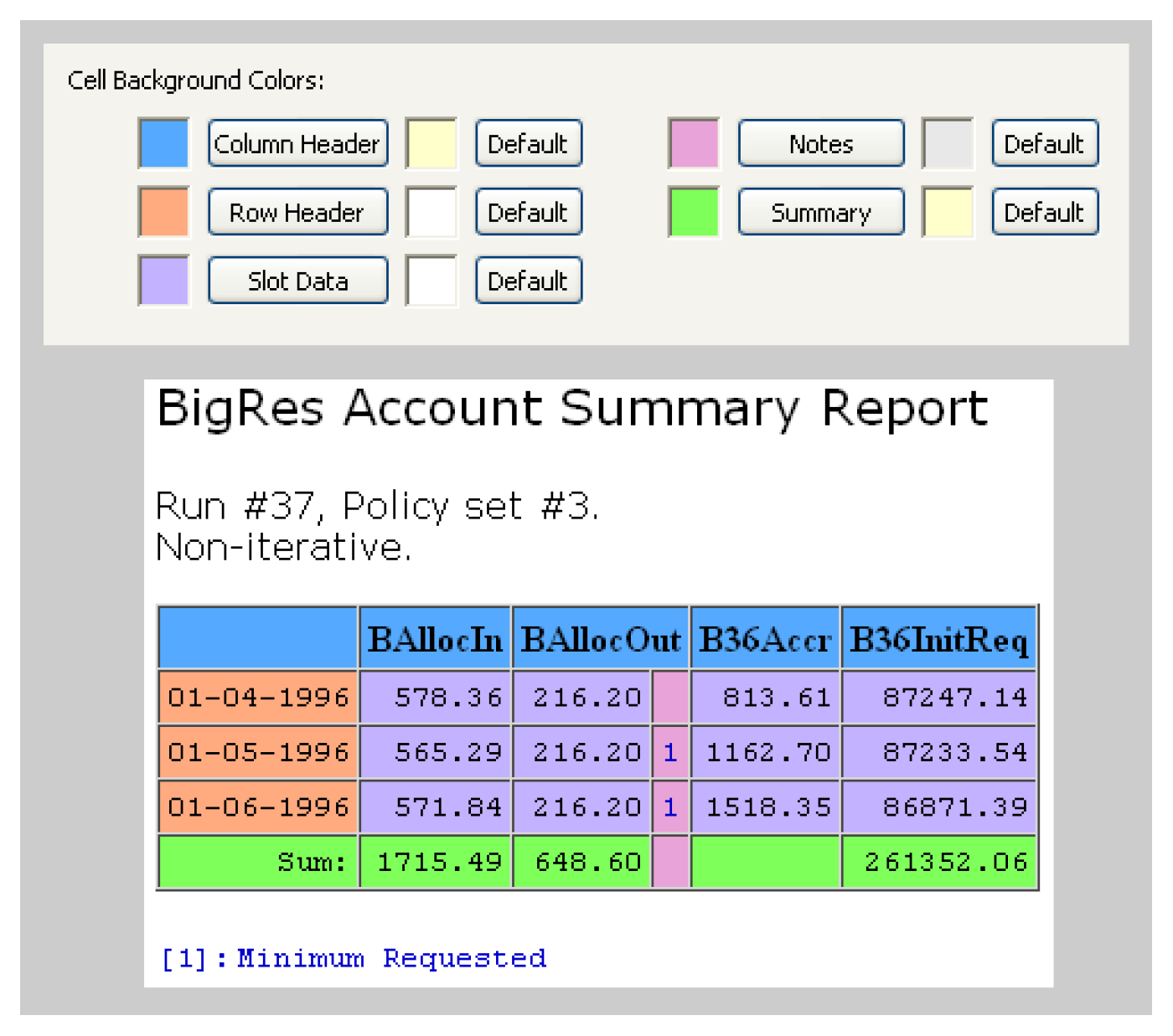
On the Output tab, selecting the titled buttons (e.g. Column Header) shows a color chooser to select the desired color. Any color setting can be reverted to the default color by selecting the respective Default button.
On the Output tab, hovering the mouse over a color display window (square) shows the six hexadecimal digit RGB (Red-Green-Blue) color code in a tooltip. This is an HTML color encoding convention. Each of the three colors (Red, Green, Blue) has a two hexadecimal digit value from 0 (“00”) to 255 (“FF”). Higher numbers are lighter colors; Black is “000000” and White is “FFFFFF”.
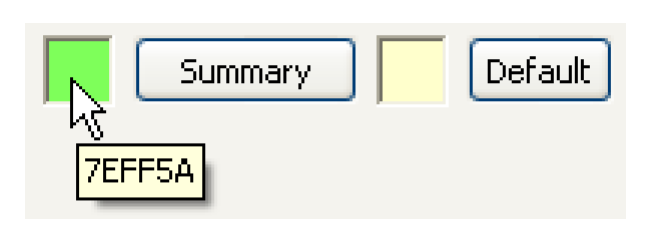
Revised: 06/06/2025